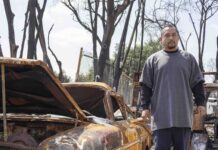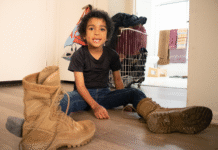Photo by: Lynn Levitt
It was Christmas Eve 1984, and 15-year-old Lisa Gonzales listened to the buzzing sound of the electric razor as it shaved clean the hair from the back of her head.
“The surgery took place and somewhere through the entire process I thought the brain tumor was caused from making bad lifestyle choices, like my use of drugs,” Gonzales said.
Recovery was a long road. For the next 12 to 14 years she suffered from headaches and nausea, though they weren’t as severe as in the past.
The experience seemed to be just a bad memory. She was happily married, had a 9-year-old son, a beautiful house and a steady career as a commercial insurance agent. Gonzales was living her dream.
That’s when the headaches returned. For 14 years they had been a tolerable annoyance, lurking under the surface as a vague reminder of that unimaginable horror half a lifetime ago.
When the mild headaches became severe, they did so with a fury. They were unbearable, agonizing waves crashing in her brain, crushing her.
From a medical perspective a clusters of small tumors had grown in her brain, centered around one large tumor. Together these masses were literally squeezing her brain.
She was unable to find a doctor to relieve this pain, so, through research Gonzales decided to go to the one “It was at the NIH where I was DNA tested and formally diagnosed with von Hippel-Lindau syndrome, (VHL)” Gonzales said.
The disease is caused by mutations of the VHL tumor suppressor. It meant, the body lacked the gene that suppresses tumor growth.
Symptoms for VHL can be as simple as a headache, or dizziness.
Pierce College Health Center Director Beth Benne is an RN and has a Public Health Nursing (PHN) certificate. She said she had never heard of the syndrome.
Some of these symptoms are very common and a student may seek help for what seems like a simple headache.
“We would follow standard protocol, checking the symptoms and if necessary get them into a medical system, full physical, possible blood-work and refer on up to the doctor level if necessary,” Benne said.
“After a full week of scans, MRIs, blood tests, etc., I found I had numerous brain tumors, tumors on my spinal cord, and kidney, and pancreatic tumors,” Gonzales said. “Basically, I had been misdiagnosed with the first surgery and should have been tested for VHL at that time.”
Vice president of Commercial Business Robert Craig has been a friend and business associate of Gonzales for over 20 years.
“She has kept up her spirit and still leads a full life,” Craig said. “She has been the recipient of many commercial insurance awards for production and is financially successful. She even raised her son alone.”
Like many who carry such serious syndromes as VHL, they feel alone. Gonzales is different. She never takes no for an answer and proceeded to help develop the VHL Clinical Care Center.
The center is to unite VHL patients with doctors and work together as a team. Someone with VHL has many specialists for different body parts, but there had not been a specialist to manage one’s care. With Gonzales’ gift of sharing and caring, she has helped doctors to organize tests, scheduling and follow-up so patients don’t have to be their own doctor, too.
Every cell in the body has two copies of every gene. In VHL syndrome, one copy of the gene has a mutation from a lack of protein. Tumors form from only the cells where the second copy of the gene has been mutated.
“I had the common sense to have my son DNA tested and it was found that he had the good VHL gene,” Gonzales said. “Therefore the disease stops with me.”
With that said, Gonzales’ other family members are not as fortunate. Both her mother and brother carry mutated genes.
Throughout the next 17 years, Gonzales had seven more brain surgeries, three left and right partial removal of the kidney, removal of part of the pancreas, the small intestine and the gallbladder called a Whipple procedure. Several X-rays, angiograms, blood tests, poking and prodding every inch and of every part of her body.
Every day Gonzales just keeps on moving like the “Energizer” Bunny. Her son is now married and she has relocated her home and business office to the Santa Clarita Valley. She still works non-stop meeting clients and writing insurance, and sets time aside for personal growth and physical activities like hiking, tennis and body sculpting.
The cycle will then turn and she will be on the surgeon’s table again. It is hard to imagine Gonzales’ VHL is not considered as aggressive as other cases.
There is no cure for VHL, just a hope that one day medicine will advance to the level of gene replacement therapy.
“I live each day like everybody should, enjoying what you have today,” Gonzales said. “My scars have become part of who I am. They give me strength each and every day I see them in the mirror.”



